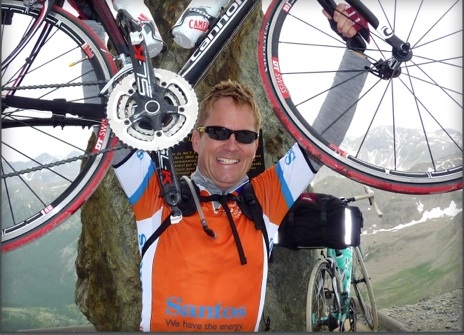By Robert Verkerk PhD, executive and scientific director
Given the workload and responsibilities most of us have to bear, it’s easy to put our physical health and fitness on the backburner. I did this for a few years myself, and my health suffered as a consequence. I even found myself weighing up the pros and cons in a similar manner when my team asked me to write this article on training tips, timed for release while Britain is amidst Olympic fever!
But, no matter how busy we are, we all need to find ways of building regular physical activity into our lives, assuming we’re capable of it. A team meeting concluded that I should focus just on the training regime I have personally been working with over the last year or so, rather than trying to cater for all body types and levels of fitness, something that would be well beyond the scope of a short article — probably necessitating an entire book! Those that followed the transalpine cycling adventure with my son back in June will know that a bit of training, jammed into a very hectic schedule, paid off, making the journey not only hugely enjoyable but considerably easier than I had envisaged. All of this despite laden bikes and rucksacks, and a vertical altitude gain that exceeded 9,000 metres (about 30,000 feet), greater than the height of Mount Everest.
 Rob Verkerk with a Cervelo hire bike (otherwise know as his dream bike) after doing 60-mile training ride outside Austin, Texas late last month
Rob Verkerk with a Cervelo hire bike (otherwise know as his dream bike) after doing 60-mile training ride outside Austin, Texas late last month
The three keys to physical activity
Three main aspects are worth focusing on when trying to develop a regular pattern of physical activity:
- Duration — how long you exercise in any one session
- Frequency — how many times you exercise, and what period of time you allow between each bout of activity
- Intensity — how intense your activity is, including what combinations of intensity, e.g. intervals, you include in a session
Most governments have developed guidelines and, while they’re not perfect, they’re certainly a lot better than not having a regular pattern of activity.
Download UK guidelines for adults, or view guidelines for all population groups.
Government activity guidelines
The UK guidelines suggest 2.5 hours (150 minutes) of activity a week in total. While this is better than less, we recommend at least 40 minutes of concerted activity every day, with more on non-working days, constituting at least 5 hours per week. The key here is building activity into your life instead of regarding it as something you do every few days, the rest of the time considering it fine to sit idle in front of a computer or television screen.
But as government guidelines make clear, this activity doesn’t need to be in the form of sport or gym activity. It may be vacuuming a house, mowing the lawn, clearing the back yard or walking to work or the shops. But, while doing these activities, be conscious that they are a form of exercise and do them briskly to ensure that your heart rate is significantly raised during the activity. A heart rate monitor can be a useful investment to help you gauge your level of activity.
For many of us, while we can make up a fair amount of our ideal 5 hours a week concerted activity in this way, there is still a need for more intense forms of activity as well. And this is where we’re going to turn our attention now.
Developing your training program
On around 3 or 4 weekdays every week, I try to get either an intense 20-minute session of exercise in before I start my day proper, or, if time allows, a 40-minute session. My decision is based to a large extent on how much sleep I’ve had the night before and whether an extra 30 minutes in bed is likely to do me more good than busting a sweat for an extra 20!
For me, this means generally setting the alarm around 5.30 am and starting my exercise on an empty stomach. There are good data to show that exercising on an empty stomach (after an overnight fast), at least two times a week, not only helps to stretch your metabolic flexibility but also improves both muscle gain and fat burn through enhanced release of human growth hormone (in both woman and men).
Below I give you a typical break down of both my typical 20-minute and 40-minute sessions. I nearly always do these sessions on a bicycle outdoors (in good weather), on a turbo trainer/exercise bike (in bad weather), on an indoor rower, or running. But they can be adapted to many other forms of activity. The sessions are essentially adaptations of the High Intensity Interval Training (HIIT) method, first proposed by sports physiologist Dr Izumi Tabata in 1996. The original Tabata protocol was about doing around 8 intervals with only 20 second bursts of activity at maximal intensity, with short 1 or 2 minute light recovery phases between the intense intervals. Depending on your sport, these can be altered, and my preferred approach is to do 30 seconds at high intensity, immediately followed by another 30 second session of maximal intensity. On a bicycle, I do the first session standing on the pedals, and the second seated. I then include a 1-, 2- or 3-minute rest period between intervals, varying this in different sessions and on different days.
To get an idea of intensity, it is very useful to use a heart rate monitor and then calculate your heart rate zones. I use a 6-zone system recommended by Fletcher Sports Science. If you know your resting pulse and your maximum pulse (using your heart rate monitor), you can use this simple heart rate zone calculator and make a note of your zones.
It's important to ensure you have at least one rest day after a couple of consecutive days of intense interval training to allow for recovery and muscle building. But again on those rest days, it doesn't mean necessarily being completely idle. Around 30 minutes to an hour of light physical activity is still ideal.
Conditioning your body
A lot of people just throw themselves into an intense exercise regime. They do it for a week or two and then give up. It feels too tough and they don’t feel good doing it. Most importantly, they lose the incentive to maintain their exercise habit. The best way around this, being not only good to keep you exercising, but also being much better for your body, is to establish a firm base for exercise before you start more intense work. For many, this is often the exercise you start in January, after being a little leisurely over the Christmas break.
If you haven’t had much of an exercise habit, you can build up by doing longish sessions of, say, 1 to 3 hours (e.g. on weekends), mainly in Heart Rate Zones 1 and 2. If you’re on a bike, you’ll probably have other cyclists passing you but don’t let this affect you. In the weeks ahead, with a firm base of fitness, you’ll be overtaking many of them!
Pre-interval resistance training session
Something cardiologist Mark Houston is very emphatic about, and that makes a lot of sense both scientifically and anecdotally, is to precede an aerobic session with resistance training. That way, you don’t leave lactate eating away at your muscles after a hard resistance session! Dr Houston typically recommends 40 minutes resistance, followed by 20 minutes of aerobic, but not all of us have the inclination for this. I will typically do around 10 to 15 minutes of resistance training (e.g. weighted squats, arm curls, sit ups, press ups, etc.) before my interval session.
Typical 20-minute interval session
- 3-minute warm-up (don’t exceed Heart Rate Zone 1)
- Interval 1: 30 seconds high intensity (Heart Rate Zone 5), 30 seconds maximal intensity (Heart Rate Zone 6)
- Recover: 2 minutes (reduce heart rate to 70% or less of Maximum Heart Rate before starting next interval, i.e. within Heart Rate Zones 1 or 2)
- Repeat interval and recovery sequence at least a further 7 times
- 3-minute cool down (bring your heart rate down to Recovery (less than 60% maximum heart rate prior to stopping)
Stretch all used muscle groups thoroughly after (but not before!) exercising. Typically this might take 5 or more minutes. Here are some simple cycling stretches.
Typical 40-minute session, with intervals
The same as above but increase warm-up session to 15 minutes, gradually building intensity through Heart Rate Zones 1, 2, 3 and 4, until the 20-minute interval session. After this, gradually reduce the intensity to the Recovery Heart Zone (below 60% of maximum heart rate zone) over 5 minutes.
As above, post-interval session stretching is essential.
Outdoor exercise
Whenever I can, I will substitute indoor training, say on a turbo trainer or indoor rower, with outdoor exercise. My preferred option is cycling. In good weather, this means cycling to work during the week when I don’t have important meetings requiring me to be better attired. And, while I have a 25-mile journey each way, I still manage intervals on my way to work, although my maximal rate tends to be a little lower for reasons of road safety. It might just get into Zone 6 (94% maximum or greater), but more often than not it’s a rather lowly high Zone 5, around 92% maximum!
On my 25-mile return journey, I will tend to simply ride steady. It’s evening by then, I’ve had a very full day, my cortisol levels are much lower, and it’s a good time for some basal endurance training at much lower rates of intensity (typically Zones 1-3, rising to 4 only on the few steep ascents between work and home). Accordingly, it takes me around 15-20 minutes longer to get home than it does to get to work!

Rob Verkerk and his son Mish 85 miles into a 100-mile sportive ascending Box Hill, near Dorking, Surrey, the road circulated 9 times by the men and twice by the women during the 2012 Olympics Road Race
On weekends, I’ll tend to go on at least one reasonable length cycle, ranging from 50 to 100 miles. If your body is not used to this kind of endurance, you can build up to it, but starting with, say, 25- or 30-mile round trips. I will tend to vary the intensity considerably with these, often adapting my riding with those around me. And I choose not to always ride with the very fastest riders I know, not only because some of the slower ones are very nice people whom I enjoy chatting with while cycling, but I also know it’s good for my body and my basal fitness. Fast cyclists, by the way, don’t talk much in the saddle, they mainly grunt!
Whatever your exercise, don’t forget to stretch all the muscle groups you’ve used properly immediately after. Eating a high protein meal or shake after is also good.
Take-home points
Physical activity is about quantity, quality, frequency and intensity. Doing little bits often is a lot better than sitting on your behind for 5 days and then doing 5 hours on a Saturday afternoon. There is no doubt that incorporating intervals into your sessions helps enormously with burning fat, developing lean muscle, reducing insulin resistance (and therefore the risk of type 2 diabetes) and building glycogen (energy) stores. Even government guidelines make these claims for exercise, and it’s a reflection of how controlling the food corporations and governments have become that similar claims cannot be made about specific food ingredients despite incontrovertible evidence!
So — if you’re not already regularly active — please get out there and get to it! I hope there’s something in this piece that helps to motivate you. The program I describe has certainly worked for me, along with specific dietary measures – but more on that another time.
Clips and images for inspiration
Following are a few links to video clips and photos added to this piece by Sophie Middleton, our campaign coordinator, who, like the rest of the ANH team, has been incorporating regular exercise into her life and has been enjoying the benefits.
Video of Olympic 2012 Men’s Road Race through Walton On Thames, Surrey before cycling on to Box Hill, Dorking where the ANH International office is situated. (Video footage courtesy of Alan Cooper)

Jade Loughlin giving it her all in a try-out for Gloucestershire Council's Come and Try sports legacy event for people with physical and sensory impairments









Comments
your voice counts
There are currently no comments on this post.
Your voice counts
We welcome your comments and are very interested in your point of view, but we ask that you keep them relevant to the article, that they be civil and without commercial links. All comments are moderated prior to being published. We reserve the right to edit or not publish comments that we consider abusive or offensive.
There is extra content here from a third party provider. You will be unable to see this content unless you agree to allow Content Cookies. Cookie Preferences